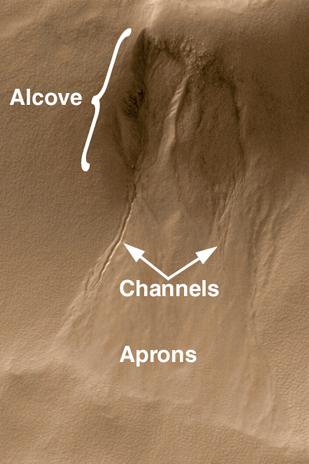Where is the Water on Mars now?
 Certainly some of the water is locked up in the Ice Caps, and some
is in the atmosphere (very little). However, it appears that significant
liquid water may lie just under the surface of Mars.
Certainly some of the water is locked up in the Ice Caps, and some
is in the atmosphere (very little). However, it appears that significant
liquid water may lie just under the surface of Mars.
Mars Global Surveyor
Launched in November, 1996, MGS began mapping Mars in April, 1999 at an
altitude of 250 miles. Perhaps one of the most significant findings
was evidence of water flowing relatively recently.
Gullies seen on Martian cliffs and crater walls in a small number of high-resolution images suggest that liquid water has seeped onto the surface in the geologically recent past (past few million years).
The gully land-forms are found on slopes facing away from sunlight, and at latitudes from 30° to 70°. The relationship to sunlight and latitude may indicate that ice plays a role in protecting the liquid water from evaporation until enough pressure builds for it to be released down a slope.

The relative freshness of these features indicate some of them are active today--liquid water may presently exist at depths of less than 500 meters (1640 feet) beneath the Mars surface.
These results from the MGS have two profound implications:
1) If water
is this accessible, it makes colonization of Mars
more feasible.
2) We should be searching much DEEPER in the Martian ground for life.
Other Current Mars Exploration Programs: Mars Odyssey, Mars Exploration Rover Mission, and Mars Express. Perhaps the most important finding so far: Evidence that the surface had been wet. See the story here.
For videos from Mars Rover, go here.
For planetary images, go here and click on your
planetary body of choice! More on Mars here.
Mars has also had its share of failures! See here.
